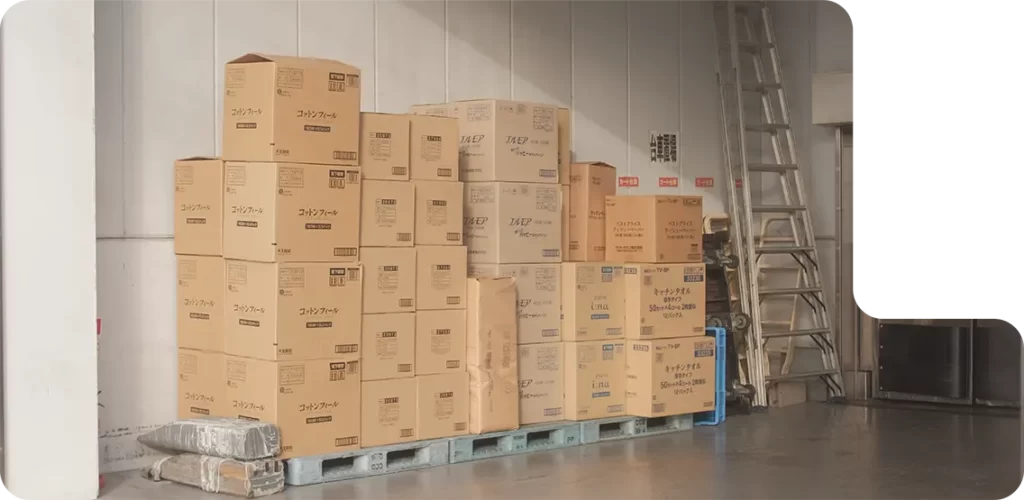Table of Contents
More Inventory Content
Share this
Subscribe to get the latest news!
Table of Contents
Share This
More Inventory Content
Subscribe to get the latest news!
What is Just-in-Time (JIT) in Inventory Management?
Just-in-time (JIT) inventory management is essential for order fulfillment in a supply chain. Although it is a part of inventory management, just-in-time inventory is a topic that needs to be focused on. JIT inventory is a part of the inventory management techniques and is also considered one of the effective techniques for it.
The just-in-time inventory method of inventory management includes working closely with suppliers so that raw materials are always ready to use in producing the final goods. This helps a business stock only the minimum amount of inventory required to be at hand and avoids overstocking.

JIT Inventory Management In Use
How and why is just-in-time inventory control essential? The first step to answering that is understanding the just-in-time inventory management process. Just-in-time inventory management ensures that the stock arrives in the warehouse as and when required by the production unit and by the customers, but no sooner. This is the crucial part of this inventory management process: the stocks should not arrive before the necessary time. This eliminates the risk of damage to the supplies and also reduces the burden of overstocking.

JIT inventory ultimately ensures that wastage is lowered and the operation efficiency is achieved. To get the raw materials when they are required in a short time, it is essential to maintain a close relationship with reliable suppliers to provide you with supplies as and when needed. In a just-in-time inventory system, suppliers play a vital role as they are responsible for delivering the raw materials and inventory at the right time without any delay, and no sooner, to the warehouse.
The just-in-time inventory management system is an effective one where there is a need to maintain close relationships with people in the organization who are associated with carrying out the work to produce better outcomes. All the people in the production unit are interconnected, and there is a constant need to inform each other about the status of the production of the final goods. It can be said that the people are mutually dependent on each other so that they can produce successful outcomes.
This practice originates from Kaizen, a Japanese term meaning “change for the better”. Although this method originated in Japan, it has spread to all countries striving for better business opportunities. The JIT inventory management system has a place at all levels of an organization, from workers to supervisors and the CEO. The goal of the just-in-time inventory method is to minimize wastage and maximize the organization’s efficiency along with the quality of the final goods.

What's the difference between JIT inventory and JIT manufacturing?
With efficient inventory management, businesses may manage the number of products coming in and going out. The better a company’s inventory management is, the more revenue it may save on operations. Overstock occurs when a business holds too much stock. Overstocked goods, also known as deadstock, often sit in warehouses, unable to be moved, eroding a company’s value. Overstocked enterprises have money-locked excess inventory, which restricts cash flow and may result in a fiscal deficit. However, if a company does not have enough merchandise, it might negatively impact customer satisfaction. A company’s revenues may suffer due to a lack of inventory. Customers may transfer their business elsewhere if you tell them you don’t have anything and keep ordering it. Firms can use an inventory management system to balance under and overstock for maximum efficiency and financial performance.

JIT Inventory: Why Do We Use It?
The just-in-time inventory management system is a very efficient one that has a lot of advantages to it. Also, companies have various reasons to opt for the JIT inventory management system. The reasons behind using the just-in-time inventory method are:
Minimize Wastage In Production
The tendency to produce more waste in the production units is common while producing final goods from raw materials and other items. In this case, employing the just-in-time inventory management method reduces wastage in production units, leading to a more effective and efficient production process.
Improve Cash Flow In A Business
The primary focus of the just-in-time inventory method is to gather raw materials at the time of production or when the customers demand them, not before or after. This ultimately results in improving cash flow in the business.
Less Need For Indirect Labor
The just-in-time inventory system requires forecasting the raw materials needed to be transferred to the warehouse. Thus, the forecasting element removes the need for extra indirect labor when carrying out the work.
Decreases Overstocking In The Storage Area
As the center point of the inventory management system is gathering the raw materials at the time of production or as per the customers’ demand, it ultimately results in a decrease in the need for storage area. As the storage area need is reduced, the problem of overstocking is also eliminated.
Healthy Relationships With The Suppliers
Maintaining a healthy relationship with the suppliers is imperative when opting for the method of just-in-time inventory in your business. Applying this inventory management system requires better relations with the suppliers, so they can be relied upon and supply you with the materials as you need them and when required, without any inconvenience.

Advantages
- This process minimizes production wastage.
- Less storage space is needed.
- Helps to maintain better relations with the suppliers and vendors.
- Decreases overstocking, as a result of which the risk of damaged products is reduced.
- The chances of overproduction are less, which limits the waiting time.
- Increases efficiency by streamlining the production process and by focusing on producing quality outputs.
- The organization becomes more agile with shorter turnaround times and fewer processes.
- Provides an opportunity to improve customer services.
- The maintenance and working schedules are done appropriately.
- As continuous improvement is practiced, it decreases the unnecessary steps in the process of production.
Disadvantages
- There is a risk of lack of preparedness in the structure of the business organization.
- Disruptions in the supply chain can harm the production process.
- The unexpected change in prices of products and raw materials may stall the JIT inventory method.
- The company may miss urgent, massive orders with few final products in hand.
- The forecasts for the production units may not be accurate and relied upon.
- Frequent stock-outs and product shortages may cause a problem.
- If the supplier is unreliable and doesn’t deliver the goods on time or in the correct quantity, it can cause a huge problem.
- The occurrence of an act of God (a natural calamity or disaster) can disrupt the whole JIT inventory management process.
- Lack of control over the time frame.
- The frequent variations in sales trends are an issue.

Example of JIT
Generally, small and big retail business houses are examples of the just-in-time inventory management process. All retailers can take huge benefits from this inventory process.
For example, there is a company that provides office furniture but does not manufacture them, but another company manufactures office furniture. So the retail company that does not manufacture the furniture but only sells them can ask the manufacturer to provide the office furniture to them only when a customer has made a purchase.
In this way, the customer’s need will be fulfilled, the stock will not get wasted, and the retailer also gets a chance to save the cost of storing the inventory, hence achieving success at both ends.
Of the many companies that follow the just-in-time inventory management method, some are stated below:
Burger King
This renowned food and beverage company always keeps the ingredients for preparing hamburgers in hand. Still, the hamburger is prepared and cooked only when a customer orders it.
Apple
The famous technologically-driven Apple company also opted for a just-in-time inventory management technique where they have independent manufacturing contractors and do not have to store all the parts of the gadgets in spacious storage areas.
Toyota Motor Corporation
Toyota is one of the best examples of the JIT inventory system, where the raw materials for making an automobile are called for only when a customer orders an automobile. This process eliminates the inventory holding cost, and the company only starts building an automobile when the purchase is made.
These famous companies are examples of the just-in-time inventory method and a testament to its effectiveness.

JIT Inventory Methodology
In the just-in-time inventory method, the raw materials or final goods are received from suppliers only when needed or when the customer has already made a purchase. The JIT inventory methodology uses many techniques to run the process smoothly while focusing on various aspects. The methods involved in the just-in-time inventory methodology are as follows:
- Maintaining a greater level of organization and physical discipline.
Focusing on better quality by looking into the more minor details. - Creating flexible changeover approaches that will reduce the setup time.
- Maintaining an ideal lot size, so it doesn’t get bigger or smaller.
- Looking up and maintaining a daily work schedule is an excellent control mechanism.
- Scheduling the distribution of labor and proper cash flow.
- Workers with diversified skills are hired to improve the production process.
- Using communication tools to maintain uniformity and visibility of control.
- One workstation can pull outputs from its previous one to carry on the ongoing process.
- Product-oriented logical plant layout makes the whole process easier.
- The worker’s will and immersion in the process are key features.
- Creation of a work environment where the workers can work in groups, effectively.

How can JIT inventory eliminate waste and reduce costs
The just-in-time inventory system depends upon holding minimum inventory in hand, making it easier for the business to do away with the problem of overstocking and arranging a larger storage area for the stock. The company cost depends on a lot of aspects, such as the cost for the storage area, workers’ wages, the caveat money to be paid to the suppliers, and other miscellaneous costs associated with running your company.
So, when your company does not have much inventory on hand, the storage area or warehouse requirement will also be smaller, making it manageable to reduce warehouse rental costs. In the same way, when your company forecasts the quantity of inventory to be stored and the labor required, it also includes the headcount of laborers to avoid extra wages.
Likewise, the amount payable to suppliers and vendors for obtaining raw materials and finished goods to be sold to customers is kept in check. Products do not remain unsold, and the business does not incur a loss due to overstocking.
Secondly, keeping these cost savings in mind, another point to note is that waste is reduced. No unsold products remain in the warehouse, and products are received from the vendors only when purchased. There is no overstocking of goods, and the risk of damaged products is diminished.

Who should use a JIT system?
When seen from a border perspective, the just-in-time inventory system works for all companies and business owners. It is a very flexible and effective model of inventory management that increases the company’s efficiency to a great level. It not only increases the company’s efficiency by saving on production time but also focuses on reducing production wastage and improving the quality of the outputs.
Talking specifically about the companies or the type of business that should objectively use the JIT system of inventory management, retail companies should be on the top of the list. The just-in-time inventory management model is best suited for retailers, as they are always required to keep some products in demand as the stock in hand. By maintaining cordial relationships with their suppliers and vendors, retailers can get an adequate supply of products in less time and of good quality. This is what the just-in-time inventory system stands for.
Therefore, retailers should opt for just-in-time inventory methods for the best results in inventory management.
Businesses that can benefit from just-in-time inventory
Just-in-time inventory is a good strategy for all business types, but especially for small retail businesses. Small businesses with regular sales can opt for just-in-time inventory techniques to easily keep tabs on their cash flow and the number of sales. This also eliminates the risk of damaged products if their inventory sits too long and goes without selling.
But small businesses are not the only ones with an advantage with just-in-time inventory management methods. Other business types have also found the JIT inventory model helpful in lowering costs and improving work processes.
- Different types of businesses that seek advantage with this particular inventory management technique are:
- Manufacturing companies
- Cafes and coffee shops
- Libraries and bookstores
- Self-publishers
- Construction businesses
- Florists
- Repairing companies
Businesses that should avoid just-in-time inventory
There are certain types of businesses where there is a need to provide the products right away when asked by their customers. One such type of retail business is a medicine shop and by extension the pharmaceutical companies that supply them.
When a customer goes to a medicine store, they always keep in mind that they won’t have to wait for days to get the medicine. Customers can just walk up to the pharmacy and get the necessary medication then and there. Hence, a medicine store is an ideal example of one such business that should avoid the just-in-time inventory system.
Businesses that should avoid opting for the just-in-time inventory method have the following features:
- If the businesses source materials internationally.
- The businesses have to process only a few orders annually.
- Businesses that have some operational limits for which they can’t delay orders.
- Businesses that are not confident about the performance of their supply chain.
- Businesses that do not have reliable employees and suppliers.

What to do before implementing just-in-time inventory as a small business
Before implementing the just-in-time inventory in a small business model, they should ensure that some operational areas of the company are “working” or not. The elements to consider before executing a just-in-time inventory system in a small business are:
Check The Turnaround Time Of Your Company
After receiving raw materials or products from the suppliers before converting them into final products and selling them to the customers, you still need a buffer time for preparing the final products. So research and forecast your turnaround time based on when you will ask your suppliers to deliver the necessary materials accordingly.
Make Sure To Have Reliable Suppliers
Suppliers play a vital role in the process of just-in-time inventory, and it is essential to have suppliers you can trust. These reliable suppliers will deliver the materials you need in the right quantities at the right time so that you can successfully carry out the just-in-the-time inventory process.
Establish
JIT’s success is dependent on vendor relationships. Examine the vendor lists. Decide on preferred vendors, negotiate deals, discuss lead times and delivery objectives, and summarize the number and metrics. Learn how to use them in the distribution chain to your advantage.
Fine Tune
Determine inventory requirements, regulations, and controls, as well as inventory movement reductions.
Research And Track The Demand Of Customers In The Market
Knowing how to increase the demand for your product and notice the change in the customers’ purchasing patterns is essential. This will help you track customer demands, eventually affecting inventory tracking. This will in turn help your small business forecast the inventory requirements.
Be Prepared To Face Disruptions In The Supply Chain
Disruptions in the supply chain are a prevalent feature of the market because demand and supply of products may rise and fall according to the needs and wants of the customers. So make sure to have alternative vendors if your regular supplier somehow does not deliver the necessary materials on time.
Just-in-time inventory control cuts waste boosts working capital, increases adaptability, maximizes personnel, and promotes team engagement.
Strategies for successful just-in-time inventory management

Just-in-time inventory is itself a strategy for efficiently managing the inventory. Some specific strategies or tips that help improve the just-in-time inventory management are:
- Reduce the inventory levels by doing away with dead stocks.
- Get rid of unsold inventory from your storage area for better strategy implementation.
- Try to fix defective products in your inventory to lower the wastage.
- Reduce scrap as much as possible in your production unit to cut production costs.
- Constantly strive to raise the inventory turnover ratio.
- Receive the raw materials on hand in low quantities to avoid overstocking.
- Try to find local suppliers as connecting to home will be much easier.
- Shorten the production cycle, which will deliver the products to customers before time.
- Using fast and effective equipment will save production time.
- JIT helps to limit the amount of working capital you need.
Sign up today and LEAVE THE LOGISTICS TO US
Sign up, and we will get back to you within 24 hours to discuss what services would be best for your business needs. Or speak with us now and tell us what you need.
FAQs
It is a type of inventory management that requires close working with the suppliers to receive raw materials and products only when required.
This inventory management method improves businesses by lowering waste, focusing on product quality, and cutting production costs.
Retailers, restaurants, tech and automobile manufacturers, Book stores, etc., are some of the types of businesses that earn the most benefit by using the method of just-in-time inventory.
The primary purpose of the just-in-time inventory system is to ensure that there is enough stock to only produce what you need and when you need, no more, no less.
Some of the benefits of a just-in-time inventory system are:
- Less wastage
- Better cash flow
- Improved efficiency
- Less cost of production
- Diminished risk of damaged products
- No burden of overstocking